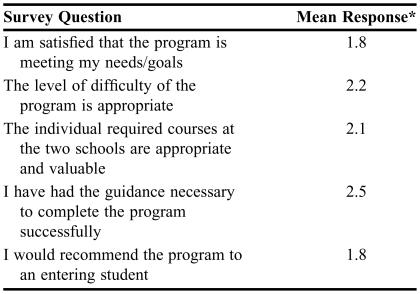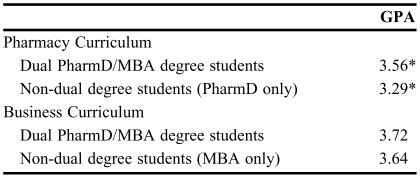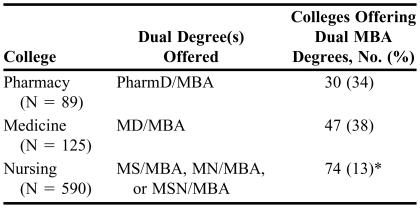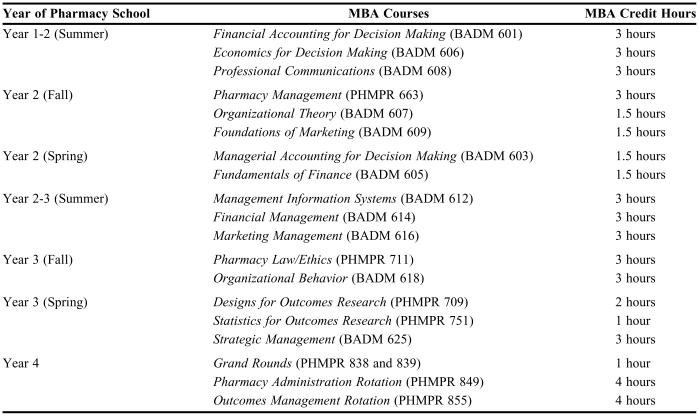Abstract
Objectives
Evaluate the academic experience and satisfaction of students enrolled in the dual PharmD/MBA degree program between the South Carolina College of Pharmacy and The Citadel's School of Business Administration. Compare grade point averages of students enrolled in the dual degree program with those of traditional student colleagues.
Methods
A standardized satisfaction survey instrument was administered to 32 students currently enrolled in the dual PharmD/MBA degree program. Grade point averages (GPAs) in both pharmacy and business coursework were also collected for analysis.
Results
There were slightly higher percentages of both female and minority students in the dual degree program compared to the pharmacy class as a whole. Eighteen (56%) of students completed the survey, and responses were generally positive. The mean GPA of students in the dual degree program was higher than that of both pharmacy (3.37 vs 3.08, p < 0.001) and business (3.72 vs 3.64, not statistically significant) students not enrolled in the dual degree program.
Conclusions
Students enrolled in the dual degree program did better academically than their counterparts and indicated an overall high level of satisfaction with the program.
Keywords: dual degree, PharmD/MBA, master of business administration, business
INTRODUCTION
Over the last few decades, dual doctorate of pharmacy/master of business administration (PharmD/MBA) programs have been developed at a number of colleges and schools of pharmacy throughout the United States. These programs have been developed with 2 primary objectives: to instill the business background and skills necessary to enter management positions within pharmacy and to allow students to earn the MBA degree in less time and at lower expense than if they were to pursue the 2 degrees independently.1 The dual degree is considered highly desirable for persons seeking careers in institutional practice settings, the pharmaceutical industry, pharmacy benefit management organizations, and academia. In fact, many professional pharmacy associations, including the American Society of Health-System Pharmacists (ASHP), have advocated the creation of such programs for the purpose of filling leadership positions in pharmacy.
According to the American Association of Colleges of Pharmacy (AACP), fully one third of the US colleges of pharmacy anticipate offering a PharmD/MBA degree in 2005-2006.2 Because the majority of these programs are relatively new and generally include only a small number of students, there are little data published in the literature on actual student experiences within these dual PharmD/MBA degree programs.
The dual PharmD/MBA degree program between the South Carolina College of Pharmacy and The Citadel's School of Business Administration is one of the largest and newest programs in the nation. This program allows students to achieve both degrees in the same 4-year period it would normally take to finish a PharmD degree alone. This conveys a significant savings in credit hours and tuition over that required of students who pursue both degrees concurrently outside of the program. As constructed, pharmacy students take the GMAT and apply to The Citadel's School of Business Administration during the spring semester of their first year in the South Carolina College of Pharmacy. The students then take MBA courses full-time during the summer of their second and third years and concurrently with pharmacy courses during the fall and spring semesters of their second and third years (no more than 3 MBA credit hours can be earned each semester during the regular school year). Required courses include Financial and Managerial Accounting, Management Information Systems, Personal Communications, Organizational Theory, and Strategic Management (Appendix 1). All of these MBA courses are offered in the evenings, so no scheduling conflicts arise.
When implementing this program, concerns matched those expressed by faculty members at other colleges who have considered dual degree programs. Because the first and foremost mission of the college is to produce pharmacists, there were questions about the potential for success of the dual degree students in the pharmacy curriculum and whether the dual degree curriculum would be too rigorous. In order to address this concern, acceptance of applications for the dual degree program was postponed until students were well into their second semester of classes at the College of Pharmacy. This gave students the opportunity to settle into the pharmacy curriculum and the unique demands of graduate school so that they could better judge whether they were interested in and capable of handling additional coursework toward an MBA. Because there were a few cases of students with relatively low first-year pharmacy grade point averages (GPAs) who chose to pursue the dual degree, admission has since been limited to those students with a cumulative first-year GPA greater than or equal to a 3.0. However, this policy was implemented after this analysis and has no bearing on the results.
The initial interest in the dual PharmD/MBA was overwhelming, producing a cohort of dual degree students with a sample size large enough to enable us to draw meaningful conclusions based on survey and academic data. The purpose of this study was to evaluate the academic experience and satisfaction of students enrolled in the dual PharmD/MBA degree program and to compare cumulative GPAs of students enrolled in the dual degree program with those of their student colleagues enrolled only in the PharmD program.
METHODS
The 32 students enrolled in the dual PharmD/MBA program were asked to complete an anonymous survey instrument, using a combination of directed questions (using a 5-point Likert scale with 1 = strongly agree and 5 = strongly disagree) and open-ended questions. The majority of these students (n = 20) were second-year pharmacy students completing their first full year in the dual degree program; the remainder were older students in their third or fourth years. The directed questions answered using a 5-point Likert scale included statements that assessed overall satisfaction with the program, its level of difficulty, required courses, and faculty guidance. The open-ended questions asked the students to document the most rewarding and frustrating aspects of the program as well as what could be done to make the program better.
To determine whether the dual degree students were performing well in the PharmD program despite the extra demands on their time, the GPAs of the college's largest cohort, second-year pharmacy students who were completing their first full year in the dual degree program (n = 20) and those in the same class who were not in the dual degree program (n = 57) were collected. To measure whether dual PharmD/MBA students were also performing well in the MBA program, the mean cumulative GPA of the 32 dual degree students was compared with the mean cumulative GPA of all other MBA students. A t test was used to determine whether the observed differences in GPAs were statistically significant.
RESULTS
Eighteen students (56%) completed the survey instrument. The overall feedback was positive, with the majority of students agreeing or strongly agreeing with each statement (Table 1).
Table 1.
Student Responses to a Survey Instrument Regarding Satisfaction With a Dual Degree PharmD/MBA Program (N = 18)
*Survey questions were answered using a Likert scale on which 1 = strongly agree, 2 = agree, 3 = undecided, 4 = disagree, and 5 = strongly disagree
Students listed exposure to the business side of pharmacy, interaction with students outside of the College of Pharmacy, and increased problem-solving, leadership, communication, and writing skills as the most rewarding aspects of the program. The most frustrating aspects of the program included dealing with registration and financial aid difficulties at 2 separate institutions and issues related to time management. To improve the program, students suggested increased communication between both colleges with regard to registration and financial aid and an increased exposure to mentors with PharmD/MBA backgrounds.
Students enrolled in the program did better academically than their counterparts (Table 2). The average cumulative GPAs of the PharmD students who elected to enroll in the dual degree program were significantly higher (mean GPA 3.37) than the average for their class (mean GPA 3.08; p = 0.01). Demographically, there were slightly higher percentages of both females (87.8% female) and minorities (27.5% minority) in the dual degree program compared to the pharmacy class as a whole (72.5% female and 20% minority).
Table 2.
GPAs of Dual PharmD/MBA Degree Students in the Pharmacy and Business Curriculums, as Compared to their Non-Dual Degree Peers
*Statistically significant difference (p < 0.01) using t test
PharmD = doctorate of pharmacy; MBA = master of business administration; GPA = grade point average
DISCUSSION
The increase in the number and popularity of dual PharmD/MBA degree programs in the United States1-5 parallels that of similar dual degree programs in colleges of nursing6-8 and medicine.9-13 There are currently 30 PharmD/MBA dual degree programs, 74 master of science/, master of nursing/, or master of science in nursing/master of business administration dual degree programs, and 47 doctor of medicine/master of business administration degree programs (Table 3).2,13,14 Despite the widespread popularity of these programs, this is the first assessment of the academic experience and levels of individual satisfaction among dual degree students in pharmacy that has been published.
Table 3.
Comparison of Dual Degree Programs in Business Administration by Colleges of Health Profession2,13,14
*Percentage based upon the number of schools (n = 590) that responded to a survey by the American Association of Colleges of Nursing of all colleges of nursing (N = 687)
Surveyed dual PharmD/MBA students indicated a high overall level of satisfaction with the program. One potential limitation to this study is the number of students involved, as just over half of the students completed the survey instrument. However, considering that few students typically enroll in dual degree programs each year at any given institution, the number of respondents to the survey (n = 18) is still relatively large.
This study also demonstrated that students in the dual program performed better academically than their peers in both curriculums. These data suggest that these dual PharmD/MBA students might have self-selected into the program with an accurate assessment of their ability to simultaneously handle the demands of 2 rigorous curriculums. As stated earlier, the program is designed to allow students to enroll in the dual degree program only after completing the first 2 semesters of the pharmacy curriculum, allowing the students to determine their interest and capability of handling additional coursework. These results affirm the continued use of this process at this institution.
In the open-ended portion of the survey instrument, students listed exposure to the business side of pharmacy, interaction with students outside of the college of pharmacy, and improvements in problem-solving, leadership, communication, and writing skills among the benefits of the dual degree program. Faculty members have noted these improvements and plan to continue to foster these opportunities and skills. The students also documented potential improvements for the program. Specifically, they indicated a need for additional advising/mentoring, especially from faculty members with PharmD/MBA backgrounds. At the South Carolina College of Pharmacy, there is one individual who meets this criteria and he currently teaches courses in the program. In order to address this issue further, the College is currently working with The Citadel to expand the number of health care professionals in their established mentoring program. In addition, the students expressed having difficulty registering for some courses, a byproduct of a larger-than-expected enrollment. Additional course sections were often added or class ceilings increased to accommodate student interest. To address concerns regarding financial aid, the financial aid offices at both institutions have met to determine the best approach for resolving issues related to their disparate federal funding cycles.
CONCLUSION
Although nearly one third of all colleges of pharmacy in the United States offer dual PharmD/MBA degrees, this is the first published formal assessment and analysis of the experience. Surveyed students enrolled in the dual program did better academically than their counterparts in both the pharmacy and business curriculums and indicated an overall high level of satisfaction with the dual degree program. These results support continuation of the dual PharmD/MBA program between The Citadel's School of Business Administration and South Carolina College of Pharmacy.
Appendix 1. Master of Business Administration Curriculum and Plan of Study for Dual PharmD/MBA Degree Students at the South Carolina College of Pharmacy
REFERENCES
- 1.Thai A, Draugalis JR. Dual PharmD/MBA programs 2001-2002: a descriptive report. Am J Pharm Educ. 2002;66:372–7. [Google Scholar]
- 2. American Association of Colleges of Pharmacy (AACP) website. Available at: www.aacp.org. Accessed July 14, 2005.
- 3.Boyd J, Zinkhan F. Campbell University joint doctor of pharmacy/master of business administration program. Am J Pharm Educ. 1993;57:105S. [Google Scholar]
- 4.Lubawy W, Yokel R, Blouin R, et al. Advanced degree programs integrated with the doctor of pharmacy curriculum as a foundation for the future. Am J Pharm Educ. 2000;64:129S. [Google Scholar]
- 5.Cotton H. An MBA for pharmacists? Am J Pharm Educ. 1979;19:54. doi: 10.1016/s0160-3450(15)32351-5. [DOI] [PubMed] [Google Scholar]
- 6.Berlin LE, Wilsey SJ, Bednash GD. Washington, DC: American Association of Colleges of Nursing; 2005. 2004-2005 Enrollment and Graduations in Baccalaureate and Graduate Programs in Nursing. [Google Scholar]
- 7.Minnick A, Weisman CS, Curgian L. The acceptance and growth of MSN/MBA programs. J Nurs Adm. 1994;24:63–8. doi: 10.1097/00005110-199411000-00013. [DOI] [PubMed] [Google Scholar]
- 8.Minnick A. Education in administration: trends in MSN/MBA and MSN in nursing administration. J Nurs Adm. 1998;28:57–62. doi: 10.1097/00005110-199804000-00011. [DOI] [PubMed] [Google Scholar]
- 9.Larson DB, Chandler M, Forman H. MD/MBA programs in the United States: evidence of a change in health care leadership. Acad Med. 2003;78:335–41. doi: 10.1097/00001888-200303000-00021. [DOI] [PubMed] [Google Scholar]
- 10.Shalowitz JI, Nutter DO, Snarr JF. Medicine and management: a combined educational program. J Health Admin Educ. 1996;14:305–13. [PubMed] [Google Scholar]
- 11.Sherill WW. Dual-degree MD-MBA students: a look at the future of medical leadership. Acad Med. 2000;75:S37–S39. doi: 10.1097/00001888-200010001-00012. [DOI] [PubMed] [Google Scholar]
- 12.Kuo JS. Swimming with the sharks – the MD, MBA. Lancet. 1997;350:828. doi: 10.1016/S0140-6736(05)62029-6. [DOI] [PubMed] [Google Scholar]
- 13. AAMC Data and MD-PhD Students. Association of American Medical Colleges (AAMC). Available at: www.aamc.org/research/dbr/mdphd/Garrison.pdf. Accessed March 23, 2006.
- 14. American Association of Colleges of Nursing (AACN). Available at: www.aacn.nche.edu. Accessed July 15, 2005.






